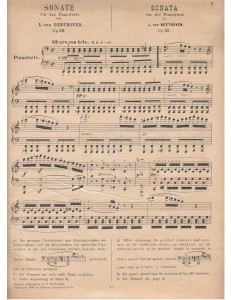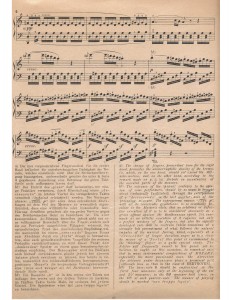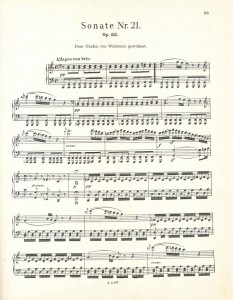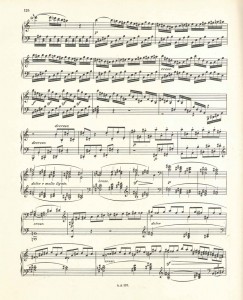A serious scholarly book publication can be recognized by the footnotes – and in a way this also applies to musical Urtext editions, because here too it is imperative to base the printed music text on appropriate evidence. Where and how this is done depends though on many parameters – amongst other things, on the question of how much verbal text the music or the practicing musician will put up with.
On that point, we must realise first of all that the idea of the Urtext edition did in fact originate at the end of the 19th century to counter the then widespread editions with commentary where explanations in and around the music text proliferated to such an extent that sometimes there was more text than music on a page of score – as Hans von Bülow’s edition of Beethoven’s Sonatas for Cotta:
The series Urtext classischer Musikwerke (Urtext of Classical Music Works) initiated in 1895 by the Royal Academy of Arts in Berlin turned against such verbal overloading of music; our modern Urtext editions go back to this impetus.
It was a challenge then as now to keep the music text in these editions as clear of commentary as possible.
Therefore we, too, traditionally group the necessary information in our Urtext editions around the music: Whereas the Preface comes up with remarks on the work’s origin and transmission, the Comments at the end of the volume provide a painstaking report as to why whichever source was or sources were consulted for the edition and where on good grounds the editor differs from them. In the Individual comments given at various measures, minor traditional differences as well as fundamental questions about the meaning of an indication can be explained so that here the interested reader finds all essential information, but is not encumbered with it while making music.
So far, so good – but experience shows that doing entirely without footnotes won’t work. That, for one thing, is because of the Urtext concept itself: even when we very accurately render the model, many times a commentary is still necessary, whether it be the translation of an uncommon performance direction such as ‘lange Haltung’ (long fermata) in Schubert’s Hirt auf dem Felsen (HN 969, S. VIII/1, just look inside) or relativizing a tempo indication by referring to the Preface as in Roussel’s Joueurs de flûte (HN 1092, S. 8/9). Such information is crucial for the performance of the music – which is why it has to be given on the music page itself.
The same goes for the classic problem with the piano sonatas of Beethoven, Mozart or Haydn: For the edition the autograph is also commonly consulted here in addition to the original edition, and when there are many differences between sources it’s hard to decide straightforwardly whether they have to do with the composer’s deliberate modification or are simply in error. This is especially so in the realm of dynamics – which is why here at crucial passages such as in Beethoven’s ‘Waldstein’ Sonata op. 53 (HN 946, S. 14/15), the editor reports the source findings in a footnote in order to make the musician directly aware of another feasible choice.
But once in a while a footnote may even have to be given sort of pre-emptively in order to ‘save’ the musician from making another choice – because often enough the unauthorized variants of a work are so generally known and popular that the Urtext can hardly prevail against them. So, numerous editions of Beethoven’s 3 Duos for Clarinet and Bassoon WoO 27 are based on a very error-ridden first edition, yet one that was soon followed by a revised print. Our Urtext edition now prints the work from this better source and requires quite a few new notes of interpreters familiar with this music – which to be on the safe side we have distinguished by footnote references to the comments (HN 974, S. 2/3).
While as a rule we are able here to be brief enough that the appearance of the music remains practically unaffected, there are also extensive footnotes at times in exceptional cases – whether it is to document an earlier version such as Haydn’s famous F-minor Variations (HN 912, S. 8/9) or in order to review the numerous authorized variants of such well-known works as Chopin’s A-flat major Ballade op. 47 (HN 937, S. 4/5) that are widely disseminated in later editions. With this as with others of our Chopin editions the footnote is not really about offering musicians a performing alternative – here they can come to know instead how a variant of this passage possibly known to them is regarded and where in the traditional context it stands. With this, though, we are heading towards the limits of an Urtext edition, actually yes, to avoiding commentary in the music text … But we find that our editions will tolerate that much verbal text – and what do you say?





Dear Annette,
Thank you for raising such an important question about the function of text in Urtext editions.
It seems to me that a printed score functions simultaneously as a reference or study document, as well as a document used for performance “on-the-fly”, as it were. Adding text and footnotes or variants serves the former use while impeding the latter. And thus a trade-off has to be made.
My first experience with Henle Urtext dates back to when I started playing the piano: Mozart K. 545, and the Bach Inventions. I loved the clean, clear, readable print, the tasteful fingering suggestions, and the footnotes that point out variants in dynamics, accidentals, and so forth. Now that I teach music, I would still recommend Henle for Bach, Mozart, Beethoven, Haydn, and Schubert — at the very least.
But over the years I have not found Henle’s solutions to the more complicated issues that arise in the works of romantic composers: say, Chopin, Schumann, and Liszt. The problem, as you well know, is that the history of revision is integral to so many of these works. The distinction between variant and variation is no longer clear!
On the one hand we have the decorative additions and changes to many of Chopin’s works, many in his own hand. (The same situation arises in Bach.) But how to weigh these changes? Were they made for a particular student, for her ease of playing? Were they “etudes” or stepping stones to guide a novice? Or were they true variants such as those compiled for standard arias? Or was it expected that the performer would add their own variants, and these serve as Chopin’s tasteful model? Those are the questions an Urtext editor must answer, and the further question remains: Where in the score should the variants be printed?
On the other hand we have Liszt, whose revisions amount to completely different works. Here it should be clear that the different versions should each be published separately, so that performers and scholars can see the individual conceptions in their own right. Then the problem to be solved is a good Preface or Commentary that compares and contrasts the versions in a lucid way.
Schumann is the most difficult case, I feel, as his revisions lie somewhere between the decorative changes of Chopin, and the wholesale rewriting or reconception of Liszt. Schumann’s edits to his early works like the Davidsbuendlertaenze or Kreisleriana are substantive, in that they change the structure of many minutes of music, but do not often involve recomposition. Still, I think the different versions of Schumann’s works deserve to stand on their own, especially in the case of the Kreisleriana, as the late Charles Rosen so eloquently argued in “The Romantic Generation”. In this case, I find Henle’s solutions to the Urtext problem quite unacceptable. Even though the first versions can somehow be “reconstructed” from the later versions, with the use of footnotes, I have found it impossible as both a scholar and musician to study those first versions from a Henle score. There is just too much flipping and jumping around — not to mention that Schumann’s notational idiosyncrasies, which are such an integral part of the original musical conception, are gone completely.
Anyway, these are some thoughts I had in response to your very thoughtful article. Love the blog.
Best,
+j